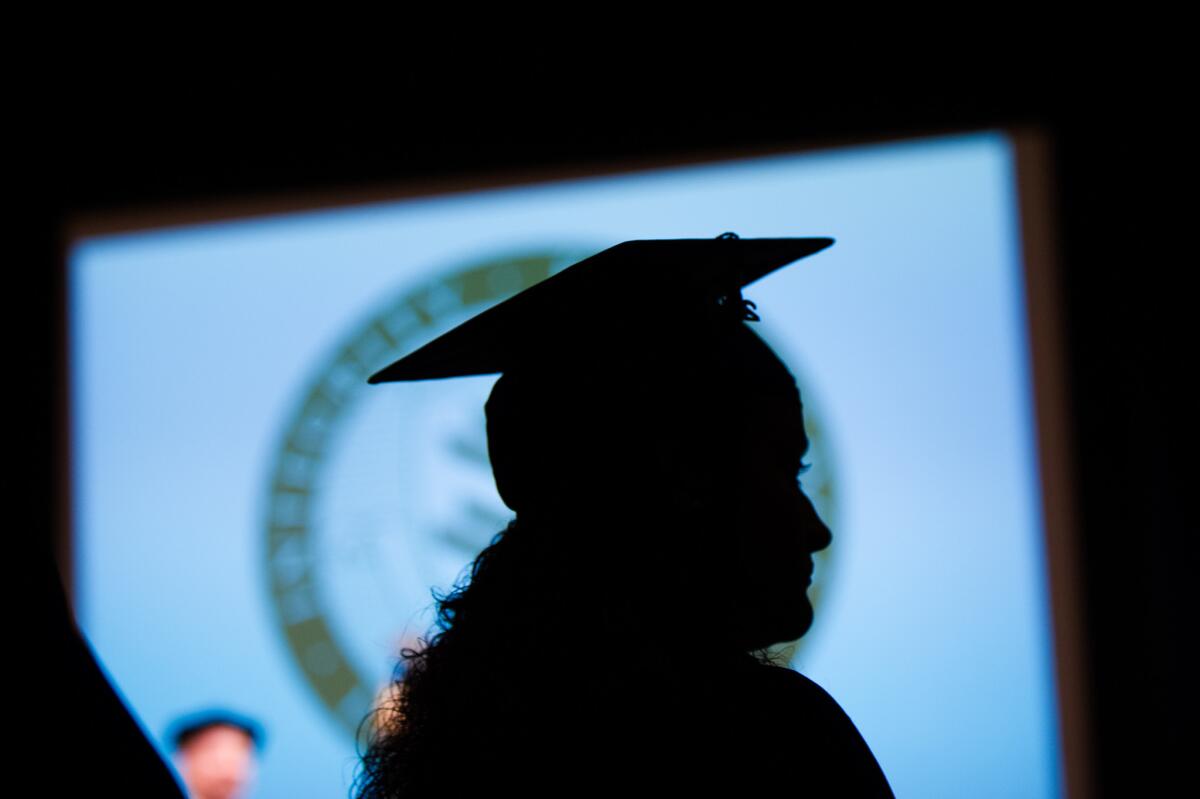How to get rich and save the world? College grads want it all

- Share via
People have been trying to pigeonhole millennials for years, particularly when it comes to those revered 20th century totems they keep destroying. You know, movie theaters, supermarkets, cars, homeownership — you name it.
But millennials and their younger brethren in Generation Z, who together make up 40% of the U.S. population, have bigger fish to fry than worrying about the disdain of their elders (not that they would, anyway).
It’s true that these generations want a career that makes a difference, even if it doesn’t pay a lot. Piles of surveys say the same thing: Many young Americans believe that, while providing some greater good to society, they can also work less than Generation X does.
The conundrum, of course, is that exploding student debt and the concentration of jobs in outrageously expensive cities make this a bit of a challenge. As they move through college and graduate school and choose a career, where to live, whether to get married or have kids, millions of young adults are demanding everything at a time when they can least afford it.
As yet another graduating class joins the workforce, we ask whether there’s a way to thread this needle. Bloomberg interviewed professors, administrators, students and recent graduates from Stanford University, the Wharton School at the University of Pennsylvania and the New School’s Parsons School of Design in New York, asking what today’s graduates are looking for and how they intend to get it. Their answers may surprise you.
“When I started at Stanford, I would have students coming by saying, ‘I love computers and I want to do it, but my folks say I have to be pre-med,’ ” recalled Terry Winograd, a retired professor who began teaching computer science at the school in the 1970s. “Later, you have people coming by and they say, ‘This computer stuff is OK. I don’t really like it, but my folks say I have to do it.’ ”
But as tech and startups took over Silicon Valley, computer science took over Stanford. It’s now among the top undergraduate majors at the school. “Back when I started, it was not the way to make money,” Winograd said. “It was for students who just loved the ideas.”
But the discipline’s reputation has changed. Today, many computer science students are in it because there’s a chance of making big money upon graduation. According to Glassdoor research, the careers of software engineer and software developer are the most popular jobs among millennials and Generation Z. But at Stanford, career goals may look a little different than elsewhere.
“There’s this thing at Stanford where getting a job is always plan B,” said former Stanford computer science major Akshay Kothari. “People would hear I’m taking a job at Microsoft and be really disappointed and say, ‘I’m sorry it didn’t work out.’ ”
After graduating with his master’s in 2010, Kothari, now 33, decided to ditch his job at Microsoft to continue working on the startup he co-founded in a design class. Around three years later, LinkedIn bought the company, Pulse, for about $90 million. Kothari now works at another startup called Notion.
Allie Miller, 31, decided to get a master’s in business administration because she “wanted to build something bigger than” herself. Her dad also got an MBA, but their motives and experiences were completely different, she said.
“I’m picturing people in bell-bottoms staying in a career for 20-plus years, whether or not that was the thing they wanted to do and whether or not they were happy,” Miller said of her father’s generation of B-school graduates.
Wharton students, the bulk of whom traditionally went into investment banking, no longer fit any one mold, said Michelle Hopping, the school’s director of career management. The largest chunk of graduates — 37% — still go into some form of financial services, but it’s no longer mostly investment banking.
“I think that there’s a personalization effort happening, where students are coming in with more specific interest areas,” Hopping said.
With more than 11 million job listings and reviews for more than 900,000 companies on Glassdoor alone, recent graduates enjoy more opportunities and more transparency than ever before. That, combined with social media, Miller said, makes it “a lot harder to not know that you are in a bad job.”
Hopping argued that millennials aren’t all that different from their predecessors when it comes to choosing a career — at least at first. They’re focused on finding work in the right industry that pays enough and has a compatible company culture, she said. The one thing that’s changed, both Miller and Hopping agreed, is the desire to make a difference rather than just make money.
“The MBA genes have mutated,” Miller said. “People in my class genuinely care about being a contributor more than a cog.”
Jasmine Yee went to an arts high school in Brooklyn, N.Y., so her parents weren’t surprised when she settled on Parsons for college. But they wanted to make sure she was committed to a career in design if she was going to spend four years studying it — and they were going to pay for it.
“I don’t come from a super-wealthy background, so this was definitely kind of risky,” Yee, 20, said. “If they were going to support me, then I was going to make it work.”
Yee’s generation is landing in a world where student debt exceeds $1 trillion, and millions of graduates are in default. For those facing student debt, there’s pressure to put those costly degrees to use and make as much money as possible. When your dream job is in media, design or the arts, that can be a tall order.
Everyone at Parsons seems to have that pressure in common, said Yee, who just finished her junior year studying product design.
“Some come with more privilege than others,” she explained. “But, with that being said, I think we’re all trying to just go for it.”
Thanks to technology, the entire design industry has evolved, creating opportunities that never existed for earlier generations, she said.
In the past, “there were 15 or 20 houses you could go work for,” Joel Towers, the executive dean at Parsons, said of the fashion industry. “Now, you can basically start your own fashion brand.”
Towers stressed that the type of student who comes to study at Parsons hasn’t fundamentally changed, but that the world they live in has.
“It’s not that they’re different — it’s that the opportunities are different,” he said.
Maybe it’s because her parents aren’t in the art world, or maybe it’s because her mother, a Brazilian immigrant, tried to provide a better life for her daughter. But either way, Yee said her work priorities are different from those of her parents.
“In other generations, it was very much about putting food on the table,” Yee said. But technology, and particularly social media, is providing young creatives a constant flow of inspiration that can help them leap forward with new ideas. That’s why, Yee said, students like her take the risk of going to design school in the first place.
“Wherever you can do what you like to do, which for us is designing and building stuff, is where you’re happy,” Yee said.
More to Read
Inside the business of entertainment
The Wide Shot brings you news, analysis and insights on everything from streaming wars to production — and what it all means for the future.
You may occasionally receive promotional content from the Los Angeles Times.










